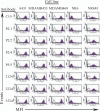Impact of single-chain Fv antibody fragment affinity on nanoparticle targeting of epidermal growth factor receptor-expressing tumor cells
- PMID: 17602702
- PMCID: PMC4198021
- DOI: 10.1016/j.jmb.2007.05.011
Impact of single-chain Fv antibody fragment affinity on nanoparticle targeting of epidermal growth factor receptor-expressing tumor cells
Abstract
To determine the importance of single-chain Fv (scFv) affinity on binding, uptake, and cytotoxicity of tumor-targeting nanoparticles, the affinity of the epidermal growth factor receptor (EGFR) scFv antibody C10 was increased using molecular evolution and yeast display. A library containing scFv mutants was created by error-prone PCR, displayed on the surface of yeast, and higher affinity clones selected by fluorescence activated cell sorting. Ten mutant scFv were identified that had a 3-18-fold improvement in affinity (KD=15-88 nM) for EGFR-expressing A431 tumor cells compared to C10 scFv (KD=264 nM). By combining mutations, higher affinity scFv were generated with KD ranging from 0.9 nM to 10 nM. The highest affinity scFv had a 280-fold higher affinity compared to that of the parental C10 scFv. Immunoliposome nanoparticles (ILs) were prepared using EGFR scFv with a 280-fold range of affinities, and their binding and uptake into EGFR-expressing tumor cells was quantified. At scFv densities greater than 148 scFv/IL, there was no effect of scFv affinity on IL binding and uptake into tumor cells, or on cytotoxicity. At lower scFv densities, there was less uptake and binding for ILs constructed from the very low affinity C10 scFv. The results show the importance of antibody fragment density on nanoparticle uptake, and suggest that engineering ultrahigh affinity scFv may be unnecessary for optimal nanoparticle targeting.
Figures








References
-
- Laskin JJ, Sandler AB. Epidermal growth factor receptor: a promising target in solid tumours. Cancer Treat Rev. 2004;30:1–17. - PubMed
-
- Nicholson RI, Gee JM, Harper ME. EGFR and cancer prognosis. Eur J Cancer 37 Suppl. 2001;4:S9–15. - PubMed
-
- Kuan CT, Wikstrand CJ, Bigner DD. EGF mutant receptor vIII as a molecular target in cancer therapy. Endocr Relat Cancer. 2001;8:83–96. - PubMed
-
- Friedman HS, Bigner DD. Glioblastoma multiforme and the epidermal growth factor receptor. N Engl J Med. 2005;353:1997–9. - PubMed
-
- Grunwald V, Hidalgo M. Developing inhibitors of the epidermal growth factor receptor for cancer treatment. J Natl Cancer Inst. 2003;95:851–67. - PubMed
Publication types
MeSH terms
Substances
Grants and funding
LinkOut - more resources
Full Text Sources
Other Literature Sources
Research Materials
Miscellaneous

